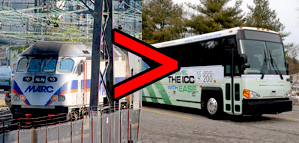|
Special Features





Image Libraries


|
|
Blog
|

Towson Row. Image from Baltimore County. |
Bethesda, Silver Spring, and Arlington are some of the best suburban downtowns in America. Baltimore’s suburbs, by comparison, have lagged behind. But with large infill projects coming to Towson and Columbia, Baltimore’s most walkable suburbs may soon catch up with DC’s.
In Towson, 1500 new residential units have opened in the past 4 years, with the largest redevelopment, Towson Row, announced just last week. The change has been enough that the Maryland Transportation Administration is now considering a Towson circulator bus network.
Columbia has further to go. Towson at least has a traditional grid of streets around which to build. Columbia, by comparison, was planned in the mid-20th Century around a mall. All Towson really needs is more buildings; Columbia must be reworked from the ground up.
|
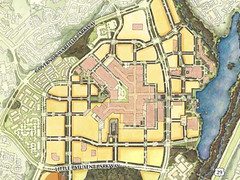 Downtown Columbia master plan. Image from Howard County. Downtown Columbia master plan. Image from Howard County. |
But they are getting there, slowly. In 2010 Howard County adopted a master plan to make downtown Columbia more urban. And now, actual projects are in the works.
Developers are moving forward with a 9-story infill project after plans for a 22-story one on the same property fell through. The shorter project is actually denser. It will have 160 apartments, 12, 000 square feet of retail, and 130, 000 square feet of office space, compared to 160 apartments, 11, 000 square feet of retail, and no office space in the 22-story version. The 22-story tower was proposed nearly 10 years ago, and was a more suburban design.
Unfortunately, for the foreseeable future both Towson and Columbia will continue to lack an important piece of the urban puzzle: regional transit. DC’s suburban downtowns have the advantage of Metro, but Baltimore’s Metro is smaller, and serves neither Towson nor Columbia. Long range plans call for an eventual light rail connection to both places, but that’s decades away.
 Cross-posted at Greater Greater Washington. Cross-posted at Greater Greater Washington.
Average Rating: 4.7 out of 5 based on 192 user reviews.
June 25th, 2013 | Permalink
Tags: bus, development, lightrail, master planning, transportation

Maryland has awarded a construction contract for the Langley Park transit center.
Langley Park is currently the busiest bus transfer location in the region that isn’t connected to a Metro station. But it’s a mess. Bus stops are spread all around the busy crossroads of New Hampshire Avenue and University Boulevard. Transit users hoping to transfer have to cross up to 14 lanes of traffic, and have to memorize which curbside bus stops their route uses. It’s a complicated and dangerous situation.
Solution: bus station.
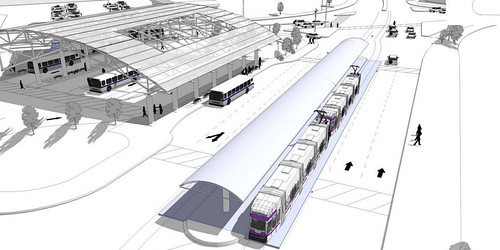
Langley Park transit center, including future Purple Line connection.
All images from Maryland MTA.
To solve this problem, Maryland has been planning for years to build a Langley Park bus station. The station would centralize all bus routes in the area under a single building, with vastly improved customer amenities.
Funding for the station was lined up in 2010 when MTA received a TIGER grant for it, but a land ownership issue delayed construction until now. Groundbreaking is expected this summer, with completion in fall of 2015.
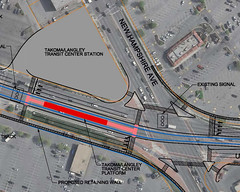
Location map. |
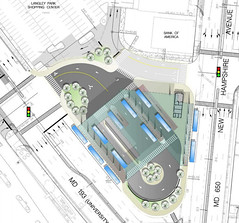
Transit center plan. |
Average Rating: 4.7 out of 5 based on 243 user reviews.
May 31st, 2013 | Permalink
Tags: bus, development, lightrail, transportation

Frequent transit maps highlight bus and rail lines that come at least every 15 minutes. They’re great tools that help riders easily identify the most convenient routes.
Such maps exist for more than 20 cities around the US, including DC. Stuart Sirota of TND Planning Group made this one, for Baltimore.

Baltimore frequent transit map, posted with permission from Stuart Sirota.
 Cross-posted at Greater Greater Washington. Cross-posted at Greater Greater Washington.
Average Rating: 4.7 out of 5 based on 151 user reviews.
May 29th, 2013 | Permalink
Tags: bus, lightrail, maps, metrorail, transportation

There was good news and bad news for Maryland transit yesterday.
The bad news was Maryland’s decision to cut bus service on the ICC. The good news was that the Purple Line, Corridor Cities Transitway, and Baltimore Red Line are all advancing, and that MARC’s Penn Line will start running on the weekend.
Overall, that’s a huge net gain for transit in Maryland.
The new BRT and light rail lines are still years away, but weekend MARC service could start as soon as this winter. The MARC news alone is a bigger win for transit than the ICC buses are a loss.
Not that there’s actually any trade here. MARC isn’t expanding service because ICC buses are going away. The two are unrelated. Just that, as a transit user, if I were given the choice between those two things, I’d definitely pick weekend MARC.
And although Maryland is deservedly criticized for the ICC, it’s also worth noting that the ICC is in the past, and the state’s current plans are extremely progressive.
Most of the new state’s new transportation money is going to transit instead of roads, and most of the road projects are relatively reasonable. There are plenty of proposed interchange improvements and widenings, but there’s no sprawl-inducing, traffic-generating outer beltway.
Average Rating: 4.4 out of 5 based on 294 user reviews.
May 17th, 2013 | Permalink
Tags: BRT, bus, commuterrail, lightrail, roads/cars, transportation

|

Charlotte streetcar construction. Photo by Reconnecting America on flickr. |
President Obama yesterday nominated Charlotte Mayor Anthony Foxx as the next Secretary of Transportation. If Foxx’s experience in Charlotte is any indication, he’ll make a strong choice.
During his nomination press conference, Foxx said “cities have had no better friend” than the US Department of Transportation under outgoing Secretary Ray LaHood, and that if confirmed he would hope to “uphold the standards” LaHood set. That’s great news.
The fact that Foxx comes from a major central city is also a huge benefit. It means he understands urban needs, which aren’t just highways.
Charlotte may not be New York, but it’s made great strides in the right direction. The city’s first rail line opened a few years ago, and a streetcar line is under construction now. Charlotte also gained bronze-level status as a bike friendly community in 2008, and launched bikesharing in 2012.
Foxx has been a strong advocate for urban rail, especially streetcars. He knows transportation and land use are tied at the hip, and has fought repeated attacks on Charlotte’s streetcar by former Mayor and current North Carolina Governor Pat McCrory.
He’s also worked as an attorney for bus manufacturer DesignLine.
Foxx also knows that state Departments of Transportation can sometimes be part of the problem. At the federal level, it’s common for USDOT to delegate responsibilities and funding to state DOTs, under the assumption the states have a better understanding of local needs. But state DOTs aren’t any more local than any huge centralized government. And since they usually focus on highways, the result is that federal dollars mostly go to highways as well.
Since Foxx fought with the state over Charlotte’s streetcar, he knows that funneling everything through state DOTs means states hold the cards. He knows that can hurt cities.
Finally, Foxx hired Arlington, VA’s former county manager, Ron Carlee, to run Charlotte’s city government. Foxx would have heard about Arlington’s reputation for progressive transportation planning during the hiring process, and presumably counted it in Carlee’s favor.
Of course, no one can really predict what kind of Secretary Foxx will be. When progressive champion Ray LaHood was first tapped for the job, the blogosphere worried his history as a Republican from rural Illinois meant he’d be a status quo highway builder.
But we do know that Foxx has made a priority of building transit in his home city, and has had to fight to make it happen.
 Cross-posted at Greater Greater Washington. Cross-posted at Greater Greater Washington.
Average Rating: 5 out of 5 based on 174 user reviews.
April 30th, 2013 | Permalink
Tags: bus, government, lightrail, people, roads/cars, streetcar, transportation

|
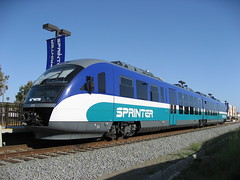
DMU train in San Diego. Photo by mrpeachum on flickr. |
In the DC region we have Metro and commuter rail trains, with light rail, streetcars, and BRT all in the works. And of course, regular buses. But one common mode we don’t have is DMU trains, which bridge the gap between light rail and commuter rail.
DMU stands for Diesel Multiple Unit. DMU trains are intended to operate on routes that look like commuter rail, but at almost light rail frequency. They go over long distances, with infrequent stations, usually on or adjacent to freight tracks. But instead of coming only at rush hour, trains come all day long, as often as every 15-20 minutes.
That’s a great service model for suburban corridors that need something better than rush-hour MARC or VRE service, but are too far away for light rail and don’t have the density to justify the costs of Metrorail.
DMUs, and their electric cousin EMUs, are used in Philadelphia, New Jersey, Portland, San Diego, Dallas, and Austin. They’re proposed in even more cities.
|
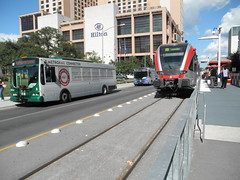
Austin DMU on-street. Photo by paulkimo90 on flickr. |
One big advantage of DMUs over traditional commuter trains is that DMUs can operate on-street, like light rail. That makes integrating them with downtown areas much easier, because it frees DMUs to go anywhere, rather than only to a city’s main rail hub.
All MARC and VRE trains to DC must go to Union Station, because all the long distance tracks through DC go to Union Station. Not only does that constrain route planning, it’s also a limit on capacity, because there are only so many platforms at Union Station. But a DMU could go anywhere.
There are not currently any plans for DMU lines in the DC region, but there could be. DMU would be a great solution for Maryland’s proposed Charles County corridor or Fairfax’s Route 28. Officials are looking at light rail for those corridors, but they’re far out in the suburbs and wouldn’t have very frequent stops, so DMU might be more appropriate.
In the long term it might also make sense to convert some of MARC and VRE’s existing lines to DMU, or to supplement them with more DMU trains. That would give them more operational flexibility, and could increase service. But MARC and VRE are established as traditional commuter rail, and may be uncomfortable with anything else.
MARC and VRE also have to use tracks owned by freight companies. DMUs can be used in mixed company with freight, although that requires federal approval. But if the freight lines are already using their tracks to capacity, which is common in the DC area, then there’s no room for more trains no matter what they look like.
DMU isn’t Metro, and it isn’t light rail. DMU trains can’t do all the things those modes can do. It’s not an appropriate mode where frequent stops are necessary. But for long corridors with infrequent stops and moderate capacity needs, it’s ideal. We should keep in mind as we continue to advocate for new transit lines.
 Cross-posted at Greater Greater Washington. Cross-posted at Greater Greater Washington.
Average Rating: 4.9 out of 5 based on 297 user reviews.
April 9th, 2013 | Permalink
Tags: commuterrail, lightrail, proposal, transportation

As Maryland moves forward with planning for the Purple Line, station designs are being released. They range from simple sidewalk shelters at the smaller stations to landmark aerial cylinders at Silver Spring and Riverside Park. Here are 6 renderings, illustrating the range of designs. More graphics are available at PurpleLineMD.com.
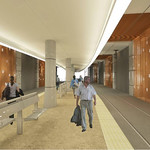
Bethesda, in a subway. |
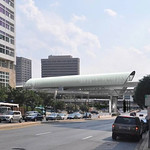
Silver Spring, elevated. |
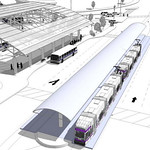
Langley Park, at-grade. |

Riverdale Park, elevated. |
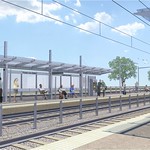
Typical at-grade side station. |
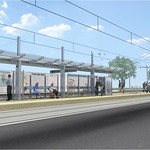
Typical at-grade center station. |
 Cross-posted at Greater Greater Washington. Cross-posted at Greater Greater Washington.
Average Rating: 4.5 out of 5 based on 252 user reviews.
April 5th, 2013 | Permalink
Tags: architecture, lightrail, transportation

|
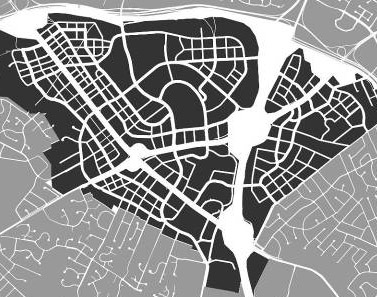
Tysons grid of streets, no. 2. |
Maryland and Virginia will both enact major new transportation funding bills this year. Neither bill says exactly which projects will be funded, but here are the top 10 projects in Maryland and Virginia that most deserve to get some of the funds.
Number 1: 8-car Metro trains. Metrorail is near capacity, especially in Virginia. More Metro railcars would mean more 8-car trains on the Orange, Blue, and Silver Lines.
Number 2: Tysons grid of streets. Tysons Corner has more office space than downtown Baltimore and Richmond put together. Converting it to a functional urban place is a huge priority.
Number 3: Purple Line. Bethesda, Silver Spring, Langley Park, College Park, New Carrollton. That’s a serious string of transit-friendly pearls. The Purple Line will be one of America’s best light rail lines on the day it opens.
Number 4: Baltimore Red Line. Baltimore has a subway line and a light rail line, but they don’t work together very well as a system. The Red Line will greatly improve the reach of Baltimore’s rail system.
Number 5: Silver Line Phase 2. The Silver Line extension from Reston to Dulles Airport and Loudoun County is one of the few projects that was earmarked in Virginia’s bill, to the tune of $300 million.
Number 6: Arlington streetcars. The Columbia Pike and Crystal City streetcars both have funding plans already, but could potentially be accelerated.
Number 7: Route 7 transit. Leesburg Pike is the next Rosslyn-Ballston corridor waiting to happen. Virginia is just beginning to study either a light rail or BRT line along it.
|

Corridor Cities Transitway, no. 8. |
Number 6: Corridor Cities Transitway. Gaithersburg has been waiting decades for a quality transit line to build around. BRT will finally connect the many new urbanist communities there, which are internally walkable but rely on cars for long-range connections.
Number 9: MARC enhancements. MARC is a decent commuter rail, but it could be so much more. Some day it could be more like New York’s Metro North or Philadelphia’s SEPTA regional rail, with hourly trains all day long, even on weekends.
Number 10: Alexandria BRT network. This will make nearly all of Alexandria accessible via high quality transit.
Honorable Mentions: Montgomery BRT network, Potomac Yard Metro station, Virginia Beach light rail, Southern Maryland light rail, VRE platform extensions.
 Cross-posted at Greater Greater Washington. Cross-posted at Greater Greater Washington.
Average Rating: 4.6 out of 5 based on 253 user reviews.
April 3rd, 2013 | Permalink
Tags: BRT, commuterrail, funding, government, lightrail, metrorail, roads/cars, streetcar, top10, transportation

Denver is in the midst of a huge regional rail expansion. That’s great, but like in many cities (including DC, historically), the urban bus system has been largely ignored amidst all the hubbub over rail.
I got my planning degree at the University of Colorado, and after discussing Denver’s bus system with some friends recently, decided to produce this map. It shows the city’s high-frequency bus routes along with its existing and future rail lines.
Although the geography is obviously different, in many ways this map is a sequel to my DC 15-minute bus map from last August. I applied a lot of the lessons learned during that exercise to this Denver map. Compared to the DC version this map shows more information, presented more cleanly.
Read more at DenverUrbanism.com.
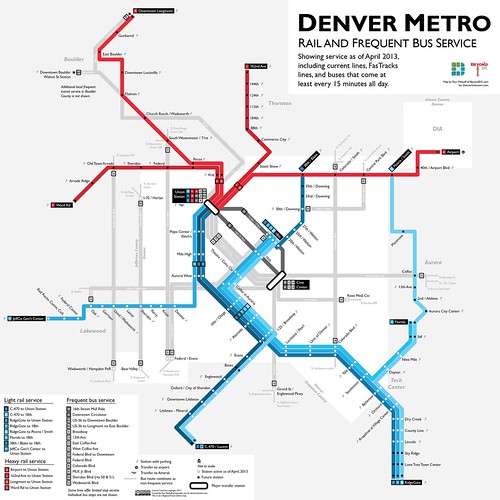
Denver rail and frequent bus map, including future lines. Click map for full size version.
Other sizes via flickr.
Average Rating: 4.6 out of 5 based on 184 user reviews.
February 27th, 2013 | Permalink
Tags: BRT, bus, commuterrail, lightrail, maps, streetcar, transportation

In late April Denver will open its newest light rail line. Most of the line runs on the surface through an old railroad right-of-way, but a few key segments are elevated above important street crossings. One such crossing, at Wadsworth Boulevard, includes this station directly atop the overpass.
The overpass bed looks like pretty typical highway infrastructure, but the station itself is light, airy, even beautiful. It’s not overwhelming, but is an undeniable and attractive landmark.
Light rail stations are much less substantial than heavy rail stations, so it’s not exactly fair to compare this to the relatively hulking Tysons Corner Silver Line stations. Light rail doesn’t need a mezzanine, and the deck doesn’t have to hold up as much weight. Regardless, a good example is a good example.
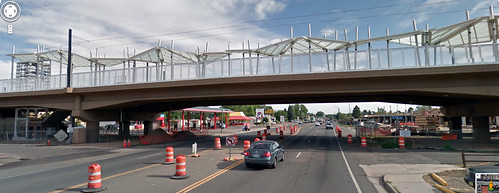
Image from Google Street View.
More photos of this station are at DenverUrbanism.
Denver is in the midst of a huge regional transit expansion program, resulting in several striking new stations. In November I posted about its awesome Union Station train shed, and its airport station is equally impressive.
Average Rating: 4.6 out of 5 based on 161 user reviews.
February 19th, 2013 | Permalink
Tags: architecture, lightrail, transportation

|
Media





Site
About BeyondDC
Archive 2003-06
Contact
Category Tags:
Partners
|

 Downtown Columbia master plan. Image from Howard County.
Downtown Columbia master plan. Image from Howard County. Cross-posted at Greater Greater Washington.
Cross-posted at Greater Greater Washington.













